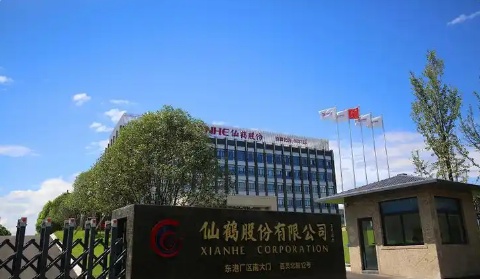11 Billion Yuan Major Investment in the Packaging Industry!
On the evening of August 6, Xianhe Co., Ltd. (603733) announced that, following thorough on-site inspections and in-depth discussions, the company officially signed the "Investment Agreement for the Integrated High-Performance Paper-Based New Materials Project for Bamboo Pulp and Paper" with the People’s Government of Hejiang County, Sichuan Province on June 30, 2025. The total investment for the project is estimated to be approximately 11 billion yuan.
The project is named the Integrated High-Performance Paper-Based New Material Project (II) for Bamboo Pulp Paper. The construction site is located in the New Material Industrial Park (III) in Lingang Street, Hejiang County, Luzhou City, Sichuan Province. Out of the estimated total investment of 11 billion yuan, approximately 5.5 billion yuan will be invested in the first phase and 5.5 billion yuan in the second phase.
The project aims to build production lines with an annual output of 800,000 tons of bamboo pulp and 1.2 million tons of high-performance paper-based new materials, along with related supporting facilities. Phase one involves an investment of approximately 5.5 billion yuan, covering an area of about 2,000 mu, to construct production lines for 400,000 tons of bamboo pulp and 600,000 tons of high-performance paper-based new materials, along with related supporting facilities. Phase two also involves an investment of approximately 5.5 billion yuan, covering an area of about 2,000 mu, to construct production lines for 400,000 tons of bamboo pulp and 600,000 tons of high-performance paper-based new materials, along with supporting projects and a bamboo plantation base.
According to the disclosed planning schedule, the project is expected to commence operations within three years from the official start of construction. The first phase of the project, once completed and operational, is expected to generate an annual output value of approximately 5.15 billion yuan, with annual tax revenue of about 450 million yuan and providing around 2,000 jobs. The second phase of the project will be invested and constructed at an appropriate time based on the implementation of the first phase, market conditions, and the company's operational status. A separate investment agreement will be signed with the People's Government of Hejiang County, Sichuan Province for the second phase, provided that the investment conditions are met.
The disclosed information indicates that the supporting facilities for the first phase of the project include alkali recovery, waste residue boiler, waste heat power generation, chlorine dioxide preparation, raw material storage, preparation system, water supply and drainage system, office building, staff dormitory, dock berths, photovoltaic power generation, and bamboo forest base. The second phase of the project, to be implemented after the completion of the first phase and based on market conditions, actual operational benefits of the first phase, and the company's operational status, plans to construct a production line with an annual output of 400,000 tons of bamboo pulp and 600,000 tons of high-performance paper-based new materials, along with corresponding supporting facilities and a bamboo forest base.
Xianhe Co., Ltd. is a large domestic enterprise specializing in the research, development, and production of high-performance paper-based functional materials. Its main business includes the research, development, production, and sales of high-performance paper-based functional materials, as well as their pulp raw materials and chemical raw materials.
In the announcement, Sun Paper Co., Ltd. mentioned that with economic development and the upgrading of consumer demand, a variety of new consumption scenarios are emerging. As a high-performance paper-based functional material, specialty paper is increasingly being custom-used in new types of consumer products, and the industry is entering an entirely new stage of development. At the same time, the use of raw materials is also entering a completely new dimension; the raw materials used to produce specialty paper are no longer limited to wood pulp from trees. The growing environmental awareness among people and the concept of green and sustainable consumption have accelerated the demand for products that “replace plastics with paper” and “replace plastics with bamboo.”
Currently, the uncertainty in the international trade environment is increasing. Although China's specialty paper production technology is rapidly advancing and achieving international breakthroughs, the main raw materials for specialty paper still have a certain degree of import dependence. This is one of the key challenges that must be overcome in the development of high-performance paper-based new materials in China. The domestic market demand for high-performance paper-based functional materials continues to grow, but the per capita consumption in China still has room for improvement compared to some developed countries.
High-performance paper-based functional materials are characterized by a wide variety of products, broad application fields, and significant development potential. Therefore, exploring the use of other plant fiber materials unique to China, aside from wood pulp, for product preparation has epoch-making significance in the development of specialty pulps and papers.

【Copyright and Disclaimer】The above information is collected and organized by PlastMatch. The copyright belongs to the original author. This article is reprinted for the purpose of providing more information, and it does not imply that PlastMatch endorses the views expressed in the article or guarantees its accuracy. If there are any errors in the source attribution or if your legitimate rights have been infringed, please contact us, and we will promptly correct or remove the content. If other media, websites, or individuals use the aforementioned content, they must clearly indicate the original source and origin of the work and assume legal responsibility on their own.
Most Popular
-

List Released! Mexico Announces 50% Tariff On 1,371 China Product Categories
-

EU Changes ELV Regulation Again: Recycled Plastic Content Dispute and Exclusion of Bio-Based Plastics
-

Mexico officially imposes tariffs on 1,400 chinese products, with rates up to 50%
-

Clariant Unveils Cost-Cutting Plan Details, Plans to Shut Down Multiple Plants
-

Nissan Cuts Production of New Leaf EV in Half Due to Battery Shortage






